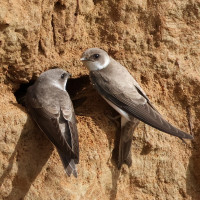Beschreibung
One lake of Kiesgrube Niederwald is used as recreational area. The other two are leftovers from sandmining. The vegetation around the lakes varies from dry grassland and farmland to lush forest. During migration locally uncommon birds come here for resting and a little break. But there are also good chances for rare species throughout the year.
Details
Zugang
Accessible by car and bike via B62 and L3073. Parking spots next to the road on the gravel. Click on the P in the map to get directions.
Terrain und Habitat
Grasland, Wiesen , Feuchtgebiet , Ebene , Vereinzelte Bäume und Büsche , See , Schlammflächen , Schilfflächen , Stadt/Dorf , LandwirtschaftBedingungen
Flach , Sandig , Offene LandschaftRundweg
NeinIst ein Spektiv nützlich?
JaGute Beobachtungszeit
GanzjährigBeste Beobachtungszeit
Frühjahrszug , HerbstzugRoute
asphaltierte Straße , Normaler WegSchwierigkeitsgrad der Tour
EinfachErreichbarkeit
zu Fuß , Fahrrad , AutoBeobachtungshütten oder -türme
NeinZusätzliche Informationen
The lake that is used as a recreational area is surrounded by trees. This is the least interesting spot. The lake on the northern side of the road is quite nice. It is also the one where you can park your car or leave your bike on the gravel in front of the iron gate. Right next to the iron gate is a higher ground from where you have a good view over the lake.
The third lake is the closest to the village and it is not visible from the road. You have to follow a path on the southern side of the road that is leading towards the village and is separated from the road by a small dike. Following the path towards the village you will reach the lake with sandbanks, small mudflats and a little island in the middle. All three lakes are private property, so be careful where you step.



